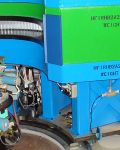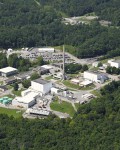Many touch screens like the one on your cell phone work because of piezoelectric materials. Piezoelectrics are ceramic or crystalline materials that produce a slight electric field when pressure is applied to them—think of your finger brushing over an icon on a screen—or conversely, a slight change in dimensions when an electric field is applied.
Piezoelectrics are a huge industry and their uses will expand if solutions can be found for a few limiting issues. Jennifer Forrester, a researcher at the University of Florida, and Krishna Nittala, a Ph.D. candidate at the university, recently used the Neutron Powder Diffractometer (NPD, at HB-2A) at HFIR to explore the structure and characteristics of piezoelectric ceramics that might lead to improved applications.
Most of the piezoelectric devices in wide use are based on lead zirconate titanate (PZT), Forrester said. Two problems limit the potential of PZT in new applications. First, ceramics are brittle, and tolerate only a slight load—approximately a 0.17% dimensional change—without breaking. Second, lead compounds are toxic.
“If you could allow a larger deformation, it would expand uses of these materials,” said Forrester. “For example, a major car manufacturer was interested in using PZT ceramics for shock absorber sensors. You can imagine the potential value, but with the present technology, if you hit a large bump in the road, you could smash the sensor and maybe wreck the bottom of your car. You would need a material that could stand a huge increase in shape change.”
Forrester used the NPD to examine crystal structures of lead-free piezoelectric ceramics with the aim of creating materials that can take more deformation and demonstrate improved properties. The instrument’s unusually high resolution was the attraction. “The crystal structures of these materials are close to cubic, but they’re off-center, asymmetric, just a little bit. That creates a net positive and negative charge across the crystal. You can’t examine them in a lab or by X-ray diffraction—because they’re so close to cubic, you won’t see where the atoms are without a high-resolution instrument.”
She examined a series of lead-free piezoelectric materials to determine their crystal structures. Next, she will measure their responses when electric fields and different loads are applied. “We want to see where the atoms move to and how far we can push them before the ceramic breaks. How far the atoms move will tell you about piezoelectric properties like strain.” How much atoms can be pushed off-center in the crystal structure shows how much load can be put on the material, she says. “You can use that to see how much it will allow the crystal structure to stretch. When we’re talking about only a 0.17% deformation, we are looking for small changes. If the strain can be increased by 0.1%, that’s a huge difference.”
Another limitation of currently used piezoelectrics is that at high temperatures they shift to a cubic structure, losing their piezoelectric properties. Nittala is examining samples of piezoelectric materials at gradually increasing temperatures as part of an effort to develop materials with higher transition temperatures. The current temperature limit for piezoelectrics is around 400°C. He examined samples at temperatures ranging from room temperature to 600°C.
“There are some applications for which you would want to use these materials at high temperatures, like fuel injectors in internal combustion engines, where the temperatures would be from 400 to 700°C. This research is to find ways to increase the temperature at which they hold their properties,” Nittala said.
Working with two mixtures of solid solutions—lead titanate and bismuth ferrite, and lead titanate and bismuth zinc oxide—–he used the NPD to measure what happens in the structures of the samples as the temperature is bumped up. One difference between the sample compounds, which have a higher transition temperature, and traditional piezoelectric compounds is that their atomic positions change with temperature in a different way, he said. “One of the atoms that is displaced slightly in the unit cell leads to the properties we see. For traditional materials, the atom displacement was linear with temperature. In these materials, we see a different trend. We are trying to quantify that. That may give us information on ways to find materials that have even higher transition temperatures.”
Forrester’s sample was 10 grams of ceramic she synthesized in her laboratory at Florida. Nittala is using samples made by a collaborator in China.
Forrester has conducted experiments at ISIS, Institut Laue Langevin, and the Australian Nuclear Science and Technology Organisation, but this was her first time to work at ORNL’s facilities. In coming months, Forrester plans to be at SNS helping to set up a stroboscopic sample environment for the NOMAD and VULCAN instruments there so she can conduct pulsed neutron studies on piezoelectric materials.
This research was funded by the U.S. Department of Energy (DOE) Office of Basic Energy Sciences.





